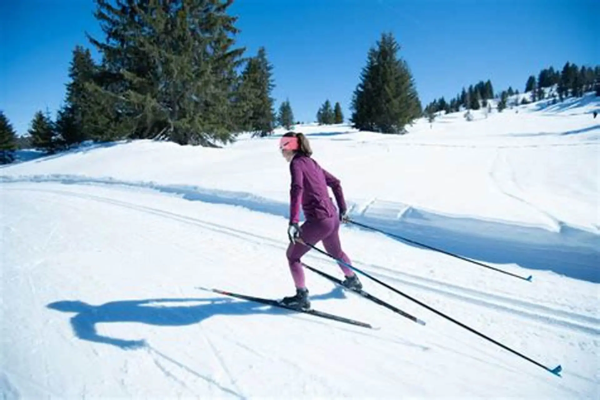Cross-country skiing, also known as XC skiing, is a popular winter sport that involves gliding over snow on specially designed skis. The sport originated in Scandinavia and has since spread to many other countries around the world. Unlike downhill skiing, which requires a ski lift or helicopter to reach the top of a mountain, cross-country skiing can be done on flat terrain or gentle slopes.
Equipment: What Do You Need?
To participate in cross-country skiing, you will need a few essential pieces of equipment. Firstly, you will need skis that are longer and narrower than those used for downhill skiing. These skis have bindings that attach to your boots, allowing you to move your feet back and forth while keeping them securely attached to the skis. Secondly, you will need boots that are comfortable and provide enough support for your ankles. Thirdly, you will need poles that help you maintain balance and generate forward momentum. Lastly, you will need appropriate clothing that keeps you warm and dry, including gloves, hats, and goggles.
Techniques: How Do You Do It?
Cross-country skiing involves several techniques that allow you to move efficiently across the snow. The most basic technique is the diagonal stride, which involves pushing off with one foot while the other foot glides forward. Another technique is the double poling, where you use both poles to propel yourself forward while your feet remain stationary. Finally, the kick and glide technique involves using your legs to push off and glide on alternating feet.
Benefits: Why Should You Try It?
Cross-country skiing offers numerous benefits for both physical and mental health:
- It is an excellent cardiovascular workout that strengthens the heart and lungs, builds endurance, and burns calories.
- Additionally, it helps improve balance, coordination, and flexibility.
- Furthermore, skiing in nature can reduce stress levels, boost mood, and enhance overall well-being.
Differences: How Does It Differ from Other Forms of Skiing?
Cross-country skiing differs from other forms of skiing, such as alpine skiing, in several ways:
- It is typically done on flatter terrain or gentle slopes, rather than steep mountains.
- The equipment used is different, with longer skis and boots that allow for more freedom of movement.
- The techniques used are different, with a focus on efficient movement rather than speed or tricks.
Getting Started: Tips for Beginners
If you’re interested in trying cross-country skiing, there are a few things you should keep in mind:
- Find a local club or resort that offers lessons or guided tours.
- Invest in quality equipment or consider renting gear until you’re sure it’s a sport you enjoy.
- Start slowly and gradually build up your skills and endurance.
Safety: What Precautions Should You Take?
While cross-country skiing is generally safe, there are some precautions you should take to ensure your safety. Firstly, dress appropriately in layers and wear protective gear such as helmets and goggles. Secondly, stay hydrated and bring snacks to maintain your energy levels. Finally, be aware of weather conditions and avoid skiing in extreme temperatures or poor visibility.
See Also: What is Jet Skiing Sport?
Conclusion
In conclusion, cross-country skiing is a fun and rewarding sport that offers numerous benefits for physical and mental health. With the right equipment, techniques, and guidance, anyone can learn to enjoy this exhilarating activity. So why not give it a try and discover the joys of skiing through nature?
FAQ:What Is Xc Skiing
Q: How does XC skiing differ from alpine skiing?
A: XC skiing involves skis that are lighter and longer than alpine skis, designed for flat terrain and gentle slopes. Unlike alpine skiing, which involves downhill skiing at high speeds, XC skiing focuses on endurance and balance while moving across flat or slightly inclined surfaces.
Q: Is XC skiing difficult to learn?
A: Like any sport, XC skiing has a learning curve. However, with proper instruction and practice, most people can quickly grasp the basic techniques. Lessons are recommended for beginners to learn the correct form and avoid injury.
Q: Where can I go XC skiing?
A: XC skiing can be enjoyed in many locations worldwide, including ski resorts, national parks, and wilderness areas. Some places offer groomed trails, while others provide opportunities for backcountry exploration. Research local options and consider joining a ski club for access to more trails and events.
Q: Can children participate in XC skiing?
A: Yes, children can enjoy XC skiing under adult supervision and with proper instruction tailored to their age and skill level. Many resorts offer programs specifically designed for kids to learn and have fun in a safe environment.
Q: How do I progress in XC skiing?
A: To improve your XC skiing skills, consider taking lessons from certified instructors who can provide personalized feedback and guidance. Joining a local ski club can also offer opportunities to train with peers and participate in races and other events.
Q: What should I expect on my first XC skiing adventure?
A: Your first XC skiing experience may feel challenging but rewarding. Expect to spend time getting comfortable with your equipment and learning basic techniques. Take breaks as needed, enjoy the scenery, and remember that practice makes perfect!

